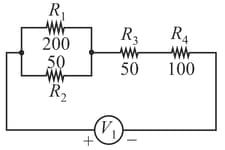Heating Effect of Current
Heating Effect of Current: Overview
This topic covers concepts, such as, Electric Power, Heat Produced in an Electrical Resistance, Power Transmission, Power Supplied by a Battery, Power Consumed by a Battery & Maximum Power Theorem etc.
Important Questions on Heating Effect of Current
Given below are two statements :
Statement I : A uniform wire of resistance is cut into four equal parts. These parts are now connected in parallel. The equivalent resistance of the combination will be .
Statement II : Two resistance and are connected in parallel in an electric circuit. The value of thermal energy developed in and will be in the ratio .
In the light of the above statements, choose the most appropriate answer from the options given below
A direct current of and an alternating current of peak value flow through resistance of and respectively. The ratio of heat produced in the two resistances in same interval of time will be :
Two bulbs and are given. Which has higher resistance?
Consider the circuit shown in the figure. In which resistor the amount of power dissipated is the largest ?

An electric iron of Power is connected to a Mains. The current drawn by the iron is nearly.
In Joules's heating law, when , and , are constant. If , is taken along the , axis and ,along ,axis. The graph is
Two heating wires of equal length are first connected in series and then in parallel. If the combinations are separately connected across the same time. The ratio of heat produced in the first case to that on the second is.
Three equal resistors connected in series with a source of emf together dissipate of power. The power dissipated by these resistors connected in parallel will be
Of the two bulbs used in a house one glows more brightly than the other. Then which of the following statements is true ?
An electric iron of Power is connected to a Mains. The current drawn by the iron is nearly.
Three equal resistors connected in series with a source of emf to-gather dissipate of power. The power dissipated by these resistors connected in parallel will be
An electric iron of Power is connected to a Mains. The current drawn by the iron is nearly.
In a large building, there are bulbs of , bulbs of , fans of and heater of The voltage of the electric mains is. The minimum capacity of the main fuse of the building will be:
The power consumed by a simple circuit having total resistance is . If the resistance is reduced by half, the power consumed will be
An electric iron of Power is connected to a Mains. The current drawn by the iron is nearly.
A fuse wire can withstand a maximum power of in circuit. The resistance of the fuse wire is:
Following figures show different combinations of the identical bulb (s) connected to identical battery (ies). Which option is correct regarding the total power dissipated in the circuit?

A light bulb of resistance is attached in series with an infinite resistor network with identical resistances r as shown below. A battery derives current in the circuit. What should be the value of such that the bulb dissipated about of power.

Two , bulbs are connected together. The combination is connected to a AC supply line. The power drawn by the combination can be:
A student in a town in India, where the price per unit (1 unit ) of electricity is purchases a UPS (uninterrupted power supply) battery. A day before the exam, 10 friends arrive to the student's home with their laptops and all connect their laptops to the UPS. Assume that each laptop has a constant power requirement of . Consider the following statements.
I. All the 10 laptops can be powered by the UPS, if connected directly.
II. All the 10 laptops can be powered, if connected using an extension box with a 3 A fuse.
III. If all the 10 friends use the laptop for , then the cost of the consumed electricity is about
Select the correct option with the true statements.
